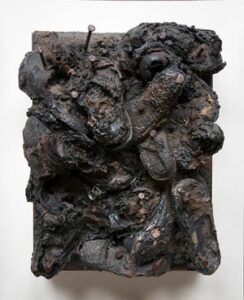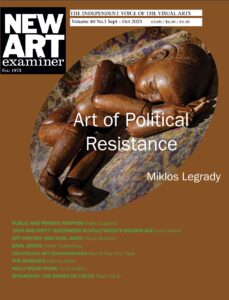
Raphael Montañez Ortiz | Archaeological Find # 22: The Aftermath | 1961 | Destroyed sofa (wood, cotton, wire, vegetable fiber and glue) on wood backing | approx. 54 x 110 x 24 inches (137.2 x 279.4 x 61 cm) | Artwork as installed in the exhibition Museum Starter Kit: Open With Care, on view at El Museo del Barrio, New York, March 12 – September 6, 2014 | Collection of El Museo del Barrio, New York | Gift of the artist with additional support from "PROARTISTA: Sustaining the Work of Living Contemporary Artists," a fund from the Jacques and Natasha Gelman Trust | emdb acc# 2007.16 | Artwork © Raphael Montañez Ortiz | Image © El Museo del Barrio, New York | Photography: Bill Orcutt
Pablo Halguera

Paper, earth, burnt shoes, nails, black paint on wood backing
Collection of El Museo del Barrio, New York. Gift of Dr. Robert Schwartz and Mrs. Diane Schwartz
There is a famous passage in Karl Marx’s Grundrisse der Kritik der Politischen Ökonomie (Foundations of a Critique of Political Economy) – an unpublished manuscript of notes-to-self that Marx made over the course of writing Das Kapital – where the German philosopher uses piano makers and piano players to make a point about labor:
‘Is it not crazy, asks Mr. Senior, that the piano maker is a productive worker, but not the piano player, although obviously the piano would be absurd without the piano player? But this is exactly the case. The piano maker reproduces capital, the pianist only exchanges his labour for revenue. But doesn’t the pianist produce music and satisfy our musical ear, does he not even, to a certain extent, produce the latter? He does indeed: his labour produces something; but that does not make it productive labour in the economic sense; no more than the labour of the madman who produces delusions is productive.’
With this little metaphor of political economy, Marx is illustrating the argument that the labor of art is in essence an unproductive activity (meaning in an economic, not aesthetic sense), and it only becomes productive when it is commodified by other forces (e.g., a gallery or a publishing house, etc.). According to Marx, ‘Labour becomes productive only by producing its own opposite (that is, capital).’
I have often thought about this passage, and thought of it again last night while looking at the work of Raphael Montañez-Ortiz, who is being deservedly recognized at El Museo del Barrio in New York with a full-scale retrospective. Montañez-Ortiz, who is probably the only living artist who has founded a museum in New York City (namely, El Museo itself), is famous for his piano-destruction performances. Montañez-Ortiz was in dialogue with Fluxus and a leading proponent of the Destruction Art Movement. He gained international notoriety during the 1966 Destruction in Art symposium in London, organized by artist Gustav Metzger, which included Montañez-Ortiz’s piano-destruction concerts.
As someone who came from a family of classical musicians, I have long been fascinated myself by the fascination that Fluxus artists had with classical instruments, particularly violins and cellos (see Nam June Paik and Charlotte Moorman), their overall appropriation of the chamber music concert format (knowing that their ironic gestures were more of a form of critique of bourgeois culture and high art and the formality that comes with it), but most particularly with the practice of piano destruction (which probably is a legacy of John Cage’s various piano interventions).
All of which also makes me think that while celebrating the work of these Fluxus artists it becomes incumbent upon us to also assess the current state of destructivism in art.
Neo-destructivism is not doing so well these days. I remember a few years ago an artist within the orbit of my acquaintances who, in true enfant terrible mode, decided to organize a book-burning performance. It mostly was met with amusement and perplexity. A few months afterward, while talking about it with a group of artist friends, a well-known artist in the group said, after a pause: “come to think of it, that piece is total bullshit.” The implication was that, at a time where post-conceptual work is fully enveloped by commodification and the market, even acts of destruction become quickly commodified in themselves and the misbehavior only serves to fulfil the expected requirements needed for the symbolic capital of the work to accumulate and eventually be repackaged as commodity – be it as a video, a photo, or a new work. If the act of destroying something is commodified, are we truly destroying something or are we helping to affirm the status quo?
Visiting Montañez Ortiz’s retrospective, I reflected on how, in some respects, the lesson of Destructivist Art was learned poorly by many of us, the subsequent generations of artists. Mainly, Destruction Art was not a nihilist act, but a post-war artistic position that saw the destruction not as an end in itself but as a strategy of transformation and even transcendence. As the artist himself writes in his Destructivist manifesto, “It is therefore not difficult to comprehend how as a mattress or other man-made object is released from and transcends its logically determined form through destruction, an artist, led by associations and experiences resulting from his destruction of the man-made objects, is also released from and transcends his logical self.”
The full spirit and meaning of this sentence might only be fully understood by looking at the scope of Montañez’s career. The destroyed objects did not disappear but instead became new, compelling artworks (the deconstructed furniture pieces on view in the exhibition are my personal favorite). And perhaps Montañez’s greatest work of all was the foundation of El Museo del Barrio. Such endeavor, which certainly was motivated by upending the status quo, could not have come but from the desire to build, to create something new. His is a career full of hopefulness.
So, destruction does not always have to be a nihilist act, and the implicit irony of the gesture might even be generative. An example that comes to mind involved a group of artist friends who worked in the early 2000s as a curatorial/artist collective, Laboratorio 060.

Collection of El Museo del Barrio, New York. Gift of the artist
Brazilian artist Ricardo Basbaum participated in Documenta 12 (2007) by presenting one of his now best-known works, Would You Like to Participate in an Artistic Experience?” The project consists in sending groups of people a kind of strange-shaped, tin bathtub-like object with a hole in the middle and inviting them to do something with it. As Javier Toscano, one of the members of the collective told me, “We were very interested in the uselessness of the object, and instead of coming up with a use for it, we decided to embrace its uselessness.” The collective thus decided to try to destroy the object, something that turned out more difficult than initially appeared. “We shot at it, we had a Flamenco dancer dance on top of it onstage, we threw it onto a ditch.” Then the collective decided to bring the object to Tultepec, a small town in the outskirts of Mexico City known for its fireworks business, which as one can imagine is a rather unsafe occupation (I remember at the time Javier telling me about the family who they hired to explode the piece, and how some of them were eerily missing various eyes and fingers). Finally, Javier continues, “we took it to a scrap metal dealer so that he would compact the object. In the end it ‘acquired’ an unidentifiable form, equally useless, but that in its materiality carried all the register of these actions. In the end the artistic experience consisted in turning the object into an excuse of a destructive act, where we created something by nullifying the object.”
By now you might have been wondering why I have not brought back Marx and the piano maker passage into this thread of thought.
In 2011 I had the opportunity to help organize a performance by the famous artist Ben Vautier at MoMA, where he presented a Fluxus concert. Many old Fluxus artist friends arrived and in different moments were spontaneously invited onstage to perform alongside Ben. The program culminated in Ben Patterson’s exhilarating Paper Piece (1960) consisting of having the audience unroll two giant rolls of paper while a very loud Tango was being played. Another key component of the concert consisted in bringing onstage an upright piano that was methodically “destroyed” by Ben and others, by nailing its keys (and thus rendering it useless) and painting it white. After the performance, the piano was left at the museum and thanks to it being donated by the artist it is now part of MoMA’s collection (I also remember that at the end of the performance Ben instructed assistants to quickly take away all the other props he had used during the concert, ostensibly, I thought, to prevent the public from grabbing and keeping them as potential valuable souvenirs/works).
I wonder what Marx might have said about this performative action and subsequent transformation of the piano from instrument to artwork. Is the destruction of a piano an example of unproductive labor, or is the fact that an otherwise average and not too valuable object (an old upright piano) that is destroyed then becomes a valuable object (a Fluxus work in MoMA’s collection) a refutation of the idea that it is the performer, and not the piano maker, the one who truly produces capital?
If Karl Marx, had lived in London not in the 1850s but in the 1960s, and had attended one of Raphael Montañez Ortiz’s piano destruction concerts, I have to wonder if he might – just might – have for a moment reconsidered his ideas around artistic labor as unproductive. And he might have even approved of the artist’s work: Marxist economist Joseph Schumpeter once wrote about ‘Creative Destruction’ (schöpferische Zerstörung), a concept partially derived from Marx’s works including the Gundrisse. Schumpeter describes the concept as a “process of industrial mutation that continuously revolutionizes the economic structure from within, incessantly destroying the old one, incessantly creating a new one.”
I can’t help but see this concept activated in the work of Montañez Ortiz, given that for all the wreckage he caused, he also yielded so much new, and significant, art.

